Pork Ribs Adobo with atsuete is another regional version of our classic Filipino stew. This Ilonggo Adobong Pula is easy to make yet loaded with bold flavors. Perfect with steamed rice!
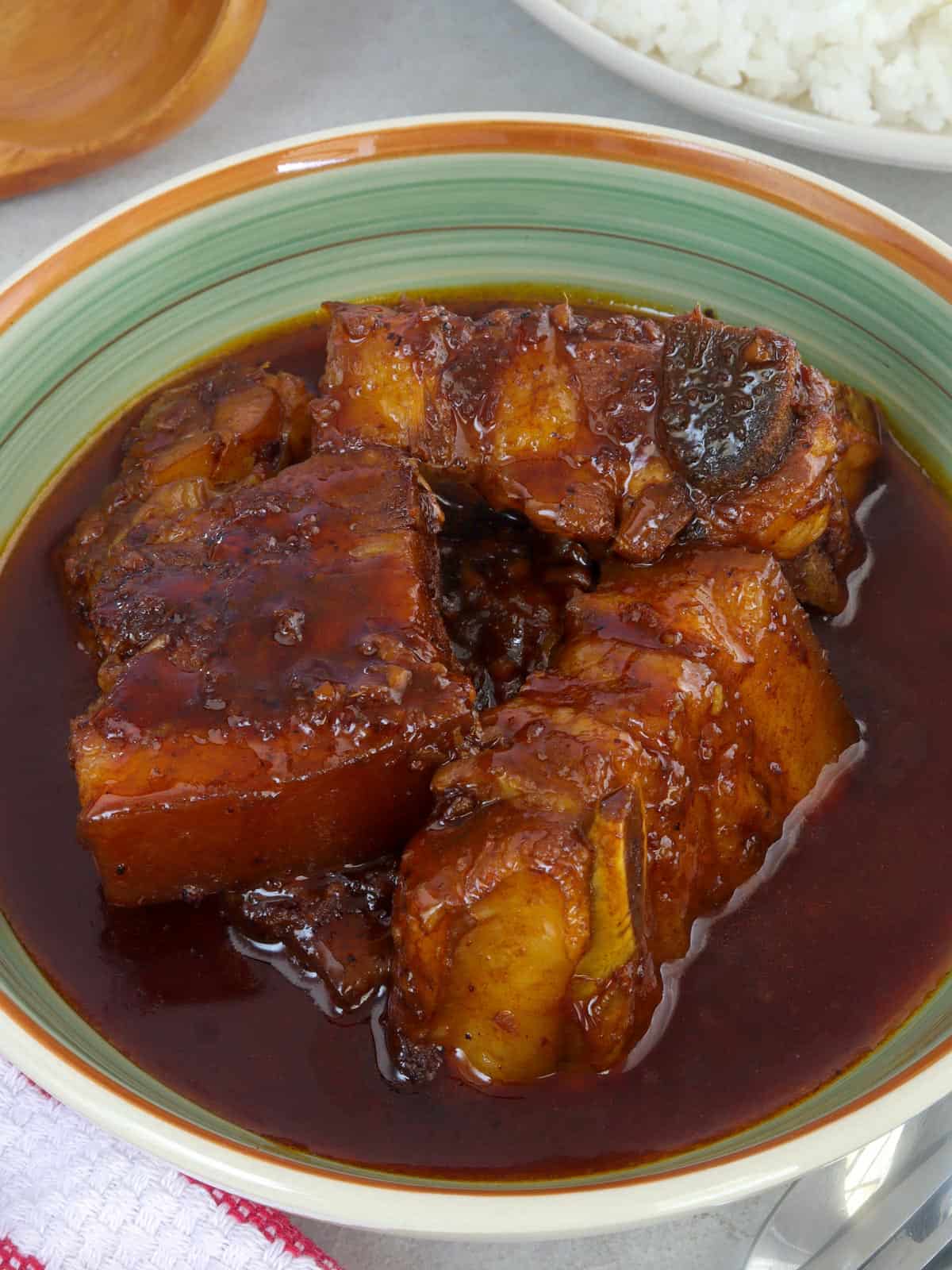
Adobo, especially adobong manok, is one of the most popular dishes in the Philippines and is considered our national dish. It is not surprising that you'll find variations of this ubiquitous stew from household to household, from one region to the next.
you'll ribs adobo with atsuete or otherwise known as adobong pula, is an Ilonggo version that adds minced ginger and annatto to the usual ingredients of garlic, vinegar, and soy sauce for an exciting twist. The procedure is the same as the classic pork adobo, requiring a simple braise to get the meat super tender and flavorful.
Ingredient notes
This adobo version includes ingredients such as ginger and atsuete, which gives it a distinct flavor.
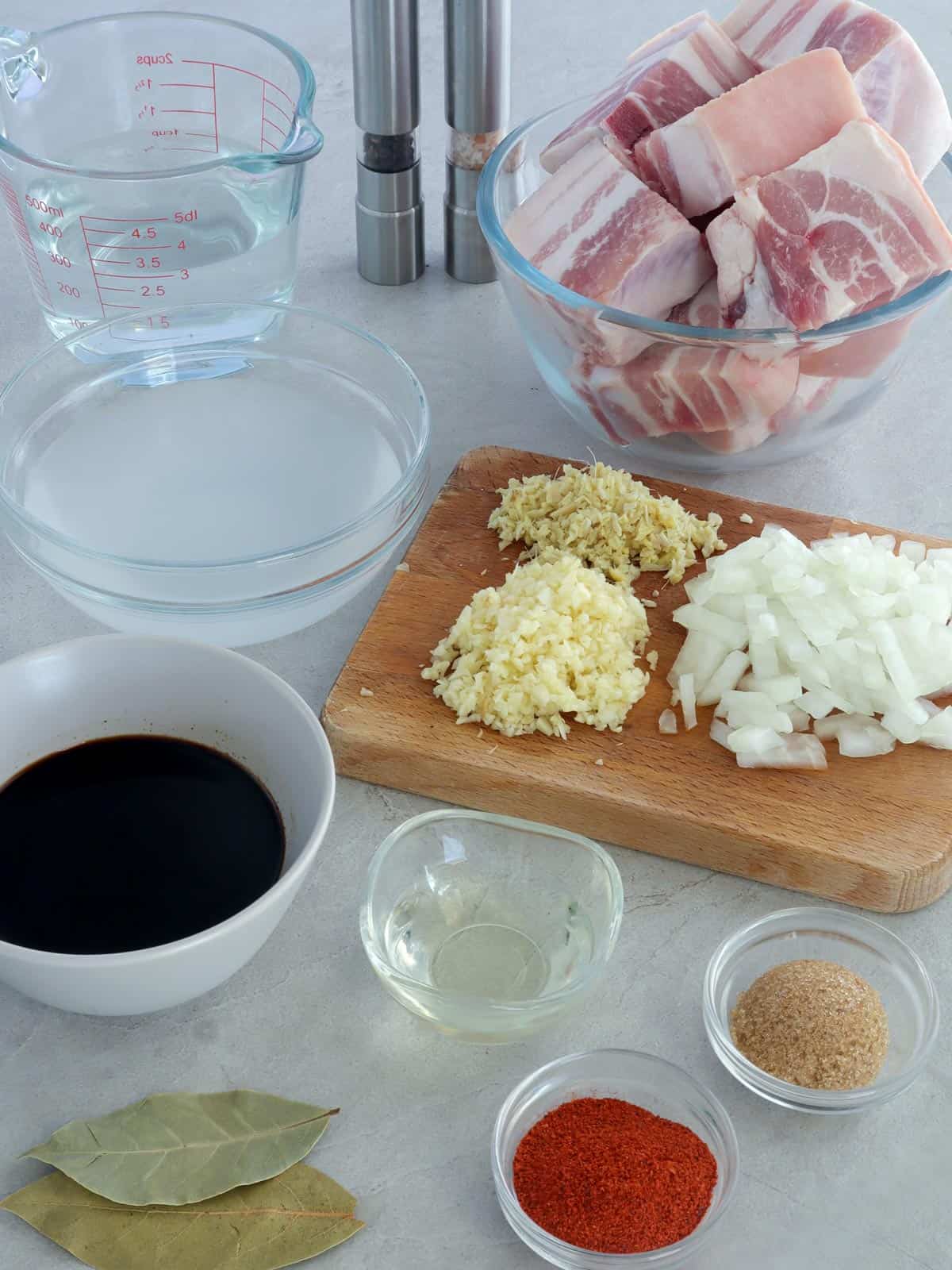
- Pork- I like to use pork belly with ribs for this recipe, but Boston butt, picnic, or spare ribs are also great options.
- Vinegar- the recipe uses palm vinegar (a Filipino brand). You might need to adjust the amount if you’re substituting white distilled, which has a more pungent taste.
- Soy sauce- adds salty, umami flavor. You can substitute salt, which is the traditional seasoning in Ilonggo adobo.
- Onions, garlic, and bay leaves- these aromatics enhance the flavor
- Ginger- adds a distinct peppery taste
- Atsuete- adds natural coloring and a slight bitterness to the dish, so use it sparingly.
- Brown sugar- When the meat is just about tender and the sauce is halfway reduced, add a tablespoon of sugar to balance the tangy flavors with a sweetness.
Pork Ribs Adobo with Atsuete cooking steps
This is a short summary; check the recipe card below for the ingredient list and detailed instructions.
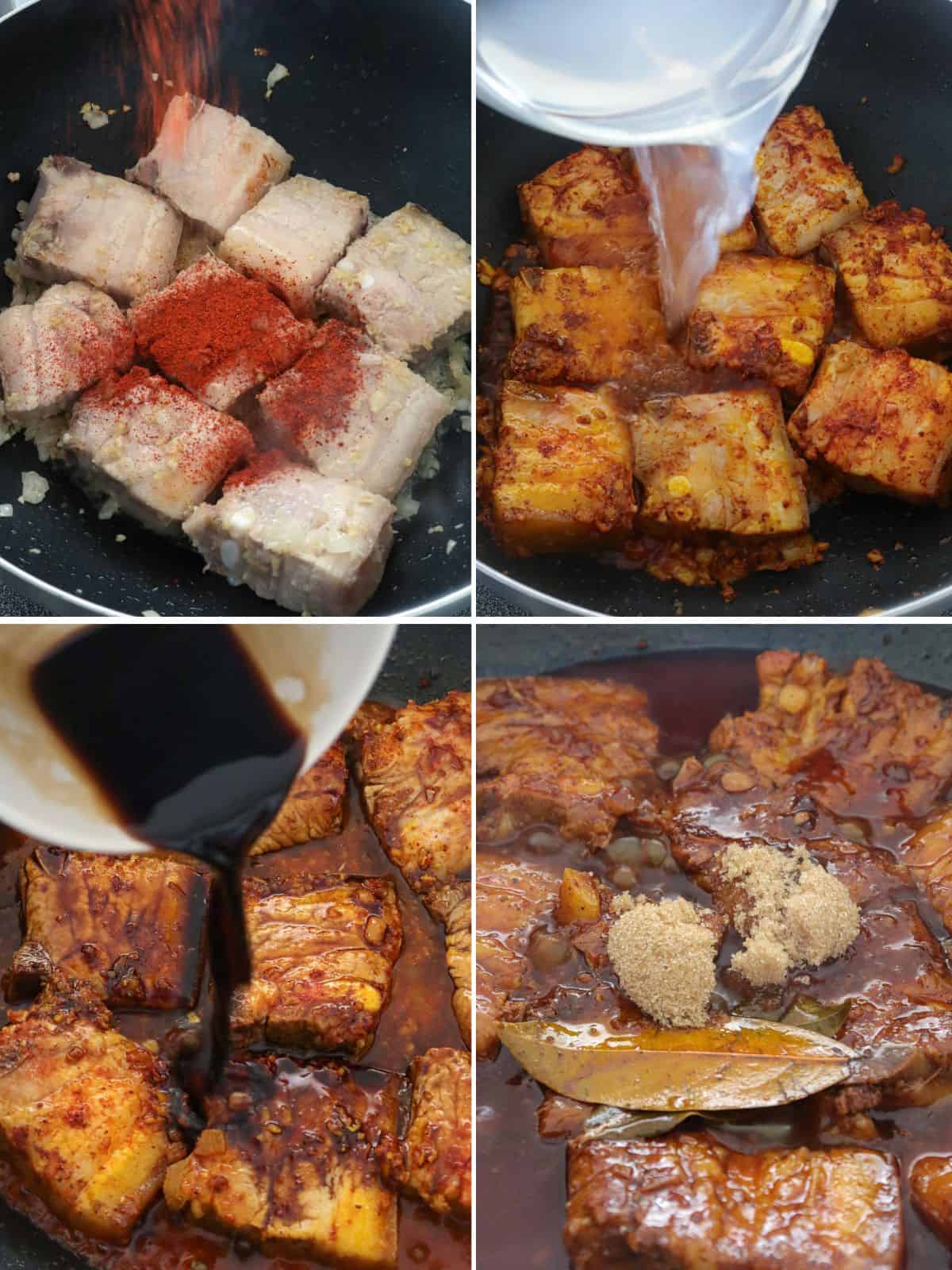
- Saute the onions, garlic, and ginger until softened and aromatic.
- Brown the pork to add depth of flavor. Pat the meat dry so it will sear properly and not steam. Do not overcrowd the pan, and cook in batches if needed.
- Add the atsuete powder and continue to cook until the pork is evenly coated.
- Add vinegar and allow to boil, uncovered and without stirring, for a good few minutes before adding the soy sauce and water to cook off the strong acid taste.
- Add soy sauce and water and continue to boil, skimming scum that floats on top. Add bay leaves.
- Simmer. Lower the heat, cover, and cook until the meat is fork-tender and the sauce is reduced.
- Sweeten with brown sugar.
- Season with salt and pepper to taste.
Cooking tips
- Cut the pork in uniform sizes to ensure even cooking.
- The flavors of the dish will concentrate as the sauce reduces, so season with salt if needed at the end of cook time to accurately gauge taste.
Frequently Asked Questions
Why do you put vinegar last in adobo?
Some recipe versions may add the vinegar last, but I prefer to add mine early in the cooking stage. Allowing it to boil uncovered and without stirring cooks off the strong acid taste and mellows out the flavor.
What is the most important ingredient in adobo?
While vinegar is crucial, adding tanginess and prolonging the dish's freshness, other ingredients, such as soy sauce and aromatics, also contribute to the overall flavor. In this recipe, atsuete adds a distinct color and taste, and brown sugar sweetens the dish.
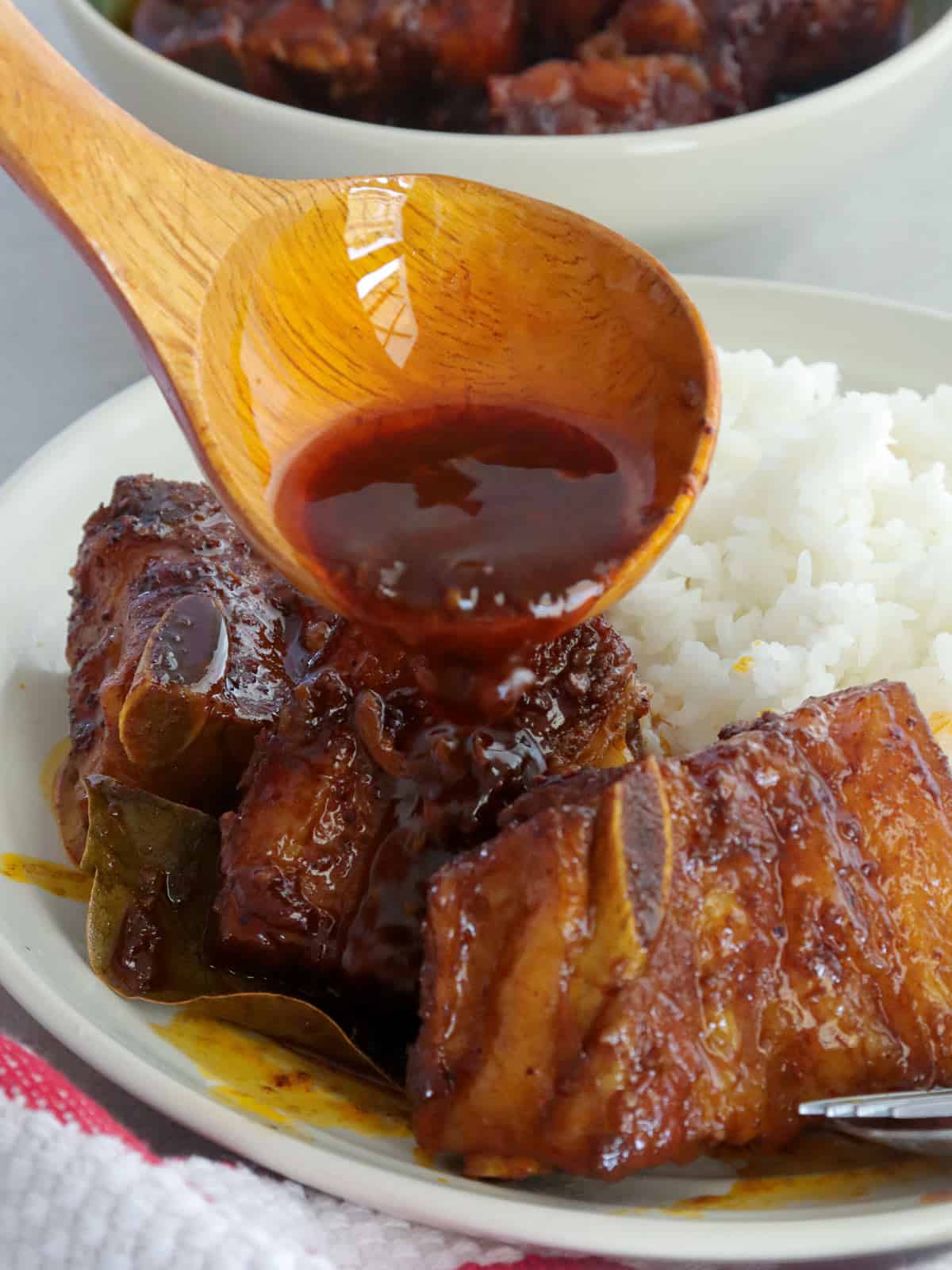
Serving suggestions
Like our adobong baboy with oyster sauce, this pork adobo with atsuete is delicious with steamed rice. Serve with pickled vegetables such as atchara, mango, or cucumber to cut through the rich taste, and enjoy!
Storing leftovers
- Adobo is a great make-ahead dish and stores well for days. Transfer to an airtight container and refrigerate for up to 3 days or freeze for up to 2 months.
- Reheat in a saucepan to an internal temperature of 165 F or warm in the microwave at 2 to 3-minute intervals, stirring well after each interval to heat evenly.
- Looking for more delicious ways to prepare this Filipino stew? Try it with luyang dilaw!
Ingredients
- 2 pounds pork belly with ribs or spare ribs, cut into 2-inch pieces
- 1 tablespoon canola oil
- 1 onion, peeled and chopped
- 6 cloves garlic, peeled and minced
- 1 thumb-sized ginger, peeled and minced
- 1 tablespoon atsuete powder
- 1 cup vinegar
- ½ cup soy sauce
- 1 cup water
- 2 bay leaves
- 1 tablespoon brown sugar
- salt and pepper to taste
Instructions
- In a wide pot over medium heat, heat oil. Add onions, garlic, and ginger and cook, stirring regularly, until softened.
- Add pork ribs and cook for about 3 to 5 minutes or until lightly browned.
- Add atsuete powder and cook, stirring regularly, until meat is evenly colored.
- Add vinegar and bring to a boil, uncovered and without stirring, for about 3 to 5 minutes.
- Add soy sauce and water. Bring to a boil skimming scum that floats on top.
- Add bay leaves.
- Lower heat, cover, and simmer for about 40 to 50 minutes or until meat is fork-tender and sauce is reduced as desired.
- Add brown sugar and stir to disperse.
- Season with salt and pepper to taste. Serve hot.
Notes
- Browning the meat to add depth of flavor. Pat dry the pork well so it’ll sear properly and not cook in their steam. Do not overcrowd the pan and use a wide pan or cook in batches as necessary.
- Allow the vinegar to boil, uncovered and without stirring, for a good few minutes before adding the soy sauce and water to cook off the strong vinegar taste.
- The flavors of the dish will concentrate as the sauce reduces, so season with salt if needed at the end of cook time to accurately gauge taste.
Video

Nutrition Information
“This website provides approximate nutrition information for convenience and as a courtesy only. Nutrition data is gathered primarily from the USDA Food Composition Database, whenever available, or otherwise other online calculators.”


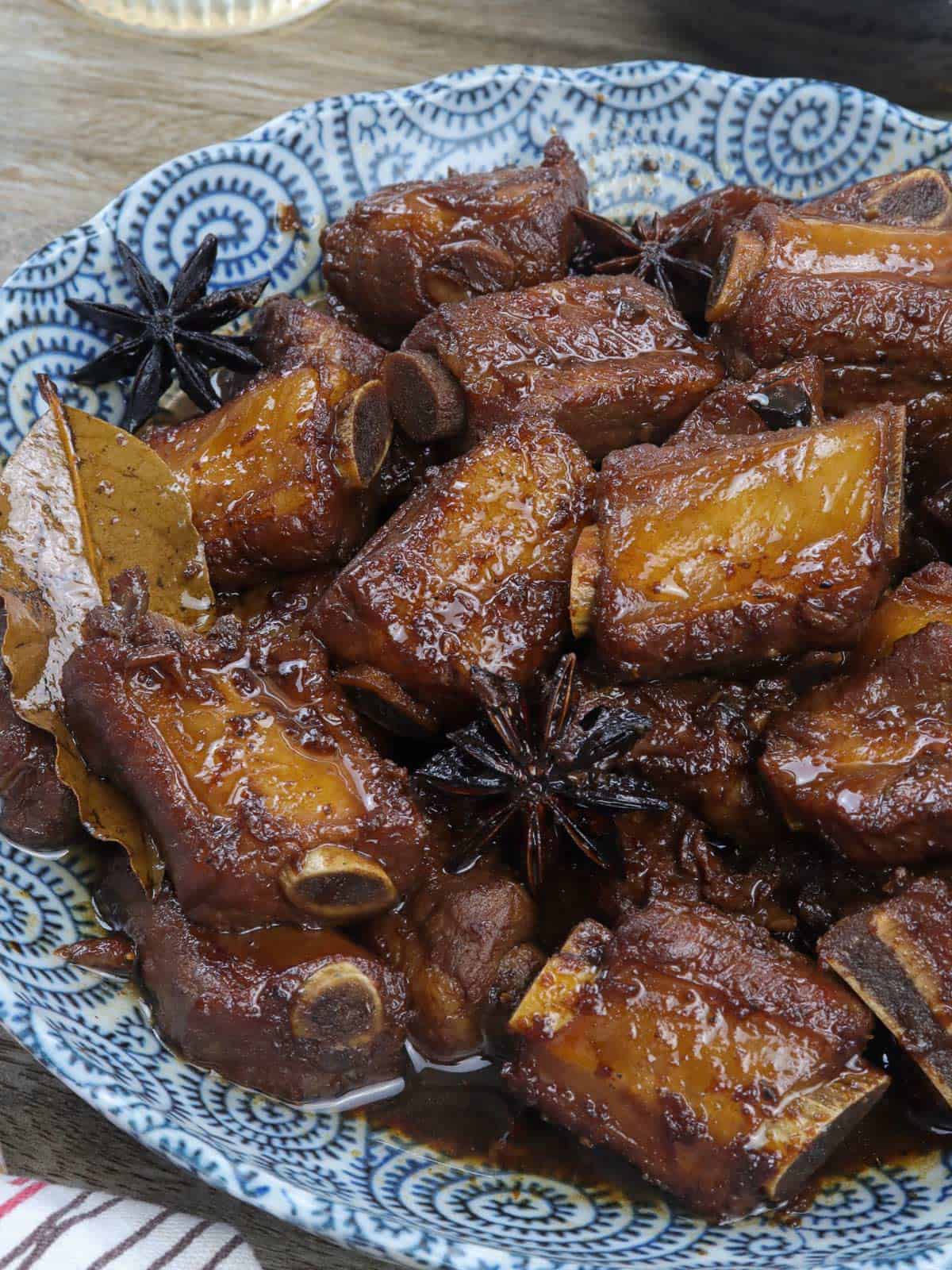

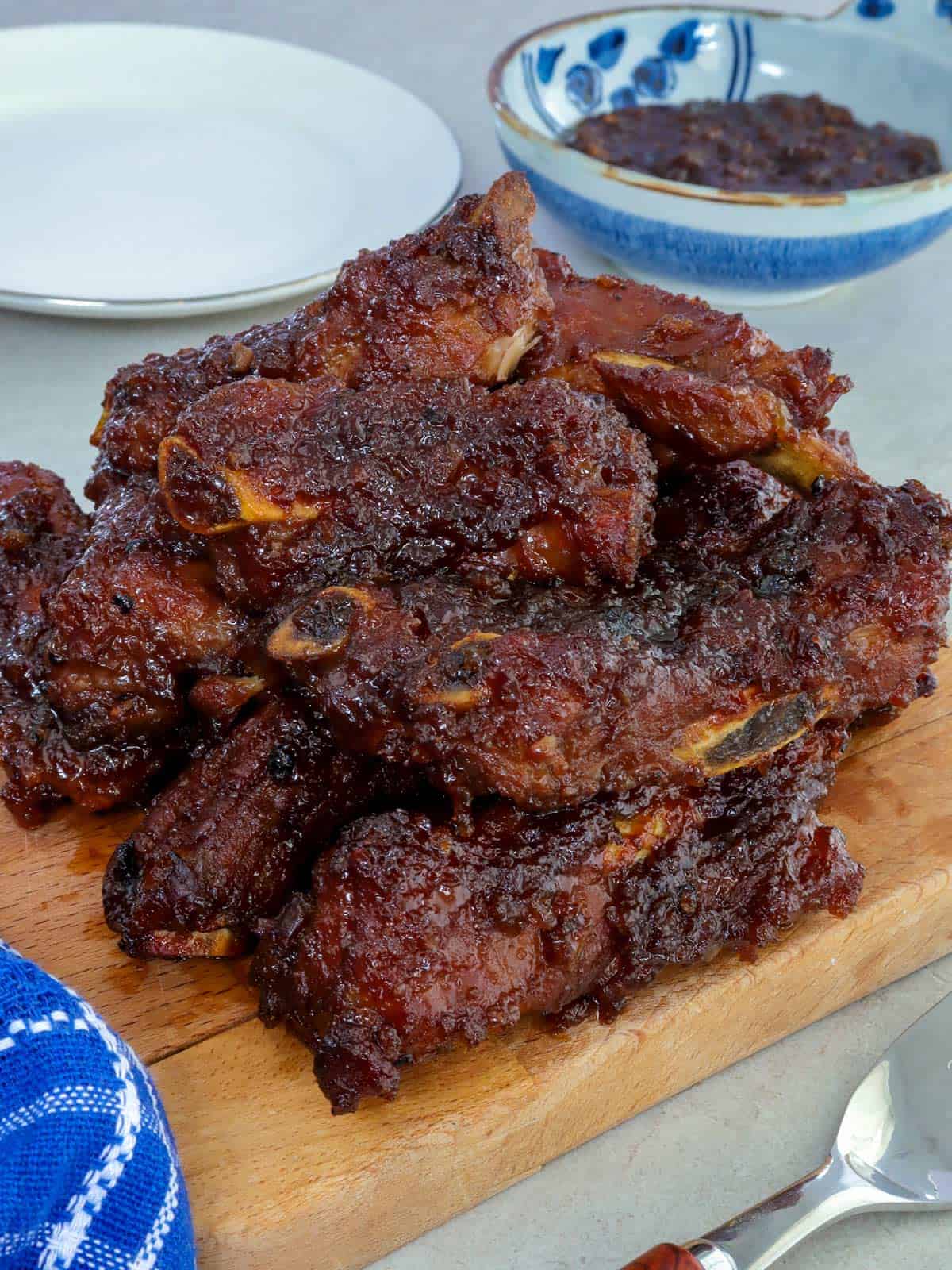
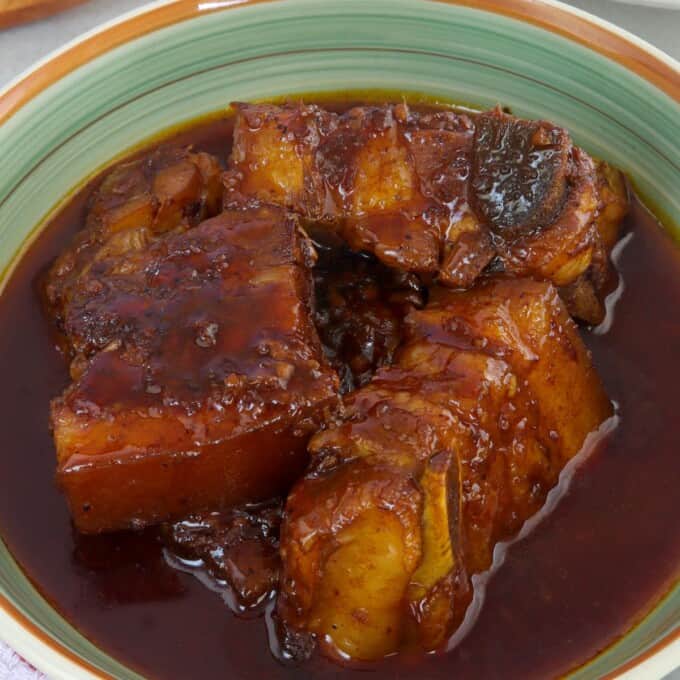


David S says
Followed your recipe but slow cooking it in a crockpot. We’ll let you know how it turns out in 4 more hours.
Myrna C. Payuran says
Thank you for this recipe. This is the adobo that my mom used to cooked for us when we were kids except it has some liver slices. Tried and followed this tecipe to a T remembering not to mix it after putting the vinegar, my family loves it, so there were no leftovers, unlike the regular adobo that I cooked. Today I am adding a few slices of pork liempo and liver and and some pcs of dried red pepper. Hope there would be no leftovers too 😊
Lalaine Manalo says
Hi Myrna! That sounds really yummy. Maybe I'll try that as well 🙂
Lailanie says
I followed this recipe to a T, and was left with a very sour adobo. No matter how much water I added to dilute the sourness, it’s still very sour. So very disappointed. I was so excited to try this recipe. I called my mom to ask why it’s so sour, and after telling her the measurements for the ingredients, she said 1cup vinegar is way too much, that it should be for every 1cup soy sauce, the vinegar should be 1/4cup - 1/2cup. This recipe has the opposite (1cup vinegar and 1/2cup soy sauce). Lesson learned (sigh).
Lalaine says
Hi Lailanie,
I am sorry the recipe didn't work for you. I use 1 cup or 8 ounces of vinegar when I make adobo and it really isn't a lot considering we're using 3 pounds of pork ribs. The trick is after you add the vinegar, you need to let it simmer uncovered and without stirring for a good few minutes to cook off the strong acid taste. This step is actually in the recipe card but I'll definitely add this tip on the post. Again, I am sorry, I know how frustrating it is to spend so much time and ingredients on a recipe for it not turn out well.
Lailanie says
I followed the recipe to a T, and I was left with a very sour adobo. 🙁 I was so disappointed. I called my mom and asked her why it’s so sour. I told her the measurements for the recipe and she said 1cup vinegar is way too much, that it should be 1/4 cup - 1/2 cup for every 1 cup soy sauce. I’m so bummed! I was so excited for this recipe. Lesson learned (sigh).
Precious says
This the type of adobe we cooked in the house it comes with asuete and ginger not only with soy sauce and vinegar just like what some Filipinos cooks sometimes it's comes with a sauce that almost like a soup
cor says
Sarap to...
Lalaine says
Yes, super sarap 🙂
Christy says
Ohoho!~ I can't even imagine how this would be perfect dish for the upcoming return of my husband from Dubai! He loves meat and I will add green chilli pepper for more spicy twist! Thank you for this!
Lalaine says
I am sure these ribs will be nice welcome for him. Is pork available in Dubai?
Green chili pepper sounds good, I love spicy foods, too 🙂
Paz Cross says
I did this recipe tonight. Hubby and my son, enjoyed it!! There are some leftovers too. They don't mind it again, "will taste better tomorrow" as my son quoted!!
Thanks so much for posting.
sbobet says
Your photo food look so very hungry.
JP says
nakakatakam.. 🙂 thank you lalaine, ribs are surely on my list this saturday! enjoy you visit and ingat!
Karla says
Mmm Namit! 🙂
Mary says
It looks so yummy ,im gonna try to cook this on next day off.. Thank you for sharing your recipes